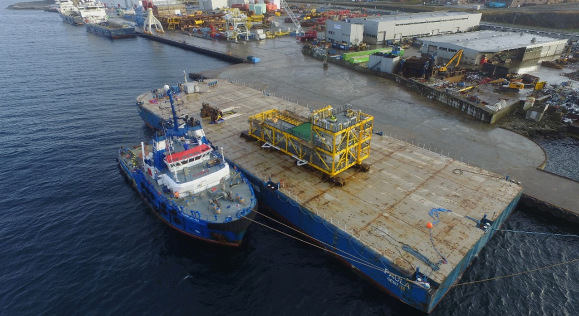Double man overboard resulting in one fatality

What happened?
During preparations for disconnecting a tow tug which was moored to a barge in turn moored to the jetty, a crew member of the tow tug fell into water between the tow tug and the barge. A second crew member also fell into the water during attempts to rescue his colleague.
Following a worsening of the weather, it was decided to disconnect the tow tug from the barge. The Chief Mate stepped over to the barge to check certain equipment, but found that he needed a torch to do so. He called for a torch by radio. An AB collected a torch and made his way to deck where the 2nd Mate was acting as safety watch for the Chief Mate. The AB handed over his radio to the 2nd Mate, who did not have a radio. Whilst the 2nd Mate was occupied with the radio, he took his eye off the AB who, at this point, fell into the water. When the 2nd Mate realised what had happened he shouted “Man Over Board” and attempted to rescue the AB. During his attempts he also fell into the water. In the meantime the MOB alarm was raised and all hands were on deck. The 2nd Mate was helped out of the water. The AB was still in the water and had now lost consciousness. After a number of attempts he was pulled towards the rescue zone door by a boat hook, where he was manually lifted out of the water. The 2nd Mate was treated for hypothermia. The AB was administered CPR and AED by the crew until medical assistance arrived. The AB was medevaced by helicopter but did not survive.
What went wrong?
- Vessel to vessel transfer was accepted and regarded as a routine activity;
- Risk awareness did not deal with specific risks of routine activities in non-routine circumstances. The focus is on what has to be done, not on how/risks involved;
- MOB between two stationary vessels was not specifically addressed in procedures, risk assessments or drills related to MOB. Rescue equipment was not primarily suitable for rescuing MOB from between two vessels.

What were the causes?
Our member notes that both the AB and the 2nd Mate were wearing inflatable lifejackets which slipped up their heads whilst they were in the water.
- Procedures and risk assessments:
- Procedures allowed direct transfer from vessel to vessel in adverse weather conditions, exceeding defined conditions (captain’s discretion);
- There was no requirement for “last minute risk assessment” (LMRA) before starting routine activities under suboptimal circumstances;
- Toolbox talks were primarily focused on which activities, less on how to execute and risks involved;
- Risk of hypothermia was not specified in the client’s procedures/risk assessments;
- Man overboard!
- MOB drills and processes tend to be related to open sea situations, and do not address falling in between two (stationary) vessels;
- Inflatable jackets are not part of drills.
- Rescue equipment was not suitable for swift retrieval of MOB between stationary vessels.
- The wearing of thermal suits was not mandatory.
- Inflatable life jackets with crotch straps was not mandatory.

Actions
- Procedures, risk assessment and toolbox talks:
- Review procedures with regard to direct vessel to vessel personnel transfer;
- Include the risk of hypothermia in procedures and risk assessments related to falling in the water;
- Review MOB procedures and drills to include MOB situations between two stationary vessels/between vessel and quayside;
- Ensure that toolbox talks not only deal with what has to be done, but also with how it should be done and the specific situational risks involved, including changes in operating conditions. Ensure that when work cannot be carried out safely anymore, the Stop Work authority is applied.
- Properly assess additional risks of carrying out routine activities under non-routine conditions;
- Equipment
- Ensure that heaving line and bag are applied for transfer of equipment/tools (such as a torch in this case) from vessel to vessel;
- Ensure that the required equipment/tools are defined prior to carrying out a non-routine job;
- Review MOB equipment and techniques used for rescue in limited situations, for example between two stationary vessels or between vessel and quayside;
- Consider introducing life jackets with crotch straps.
Members may wish to refer to
- HSSE 025 Guidance on the Transfer of Personnel to and from Offshore Vessels and Structures
- HSSE 029 Mooring practice safety guidance for offshore vessels when alongside in ports and harbours
- SEL 035 In the line of fire video
- SEL 038 Mooring incidents video
- Non-Fatal Man Overboard Incident [during mooring operations]
- MAIB: Fatal Man Overboard Incident Whilst Boarding Tug [during mooring operations]
Safety Event
Published: 13 July 2020
Download: IMCA SF 21/20
IMCA Safety Flashes
Submit a Report
IMCA Safety Flashes summarise key safety matters and incidents, allowing lessons to be more easily learnt for the benefit of all. The effectiveness of the IMCA Safety Flash system depends on Members sharing information and so avoiding repeat incidents. Please consider adding safetyreports@imca-int.com to your internal distribution list for safety alerts or manually submitting information on incidents you consider may be relevant. All information is anonymised or sanitised, as appropriate.
IMCA’s store terms and conditions (https://www.imca-int.com/legal-notices/terms/) apply to all downloads from IMCA’s website, including this document.
IMCA makes every effort to ensure the accuracy and reliability of the data contained in the documents it publishes, but IMCA shall not be liable for any guidance and/or recommendation and/or statement herein contained. The information contained in this document does not fulfil or replace any individual’s or Member's legal, regulatory or other duties or obligations in respect of their operations. Individuals and Members remain solely responsible for the safe, lawful and proper conduct of their operations.
